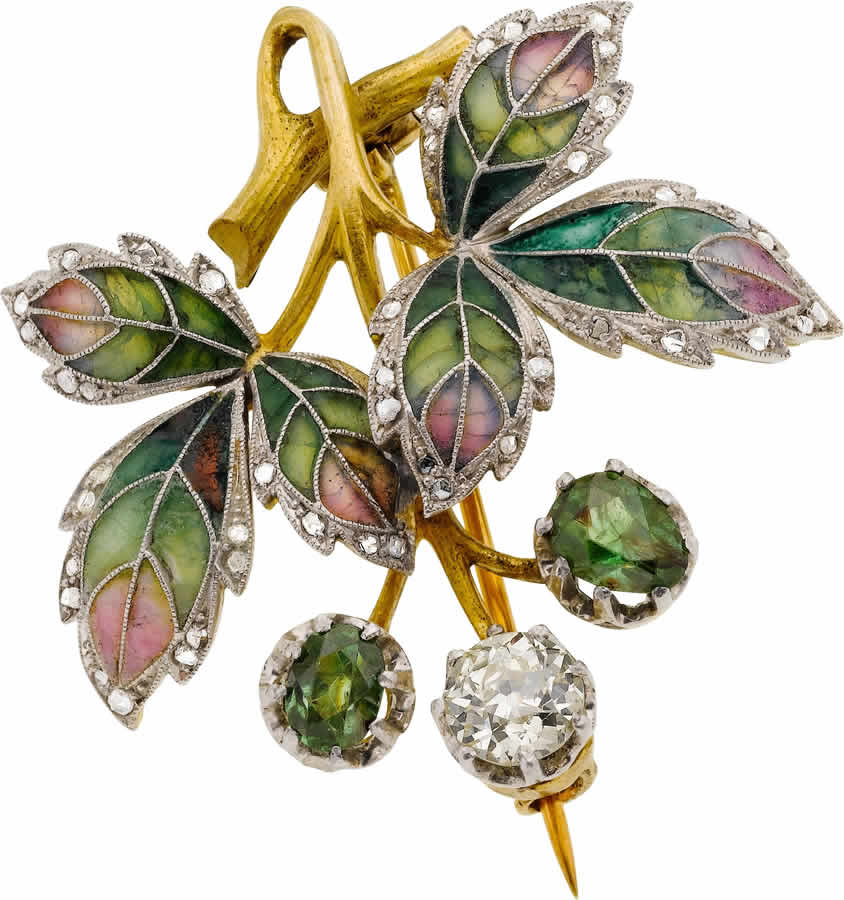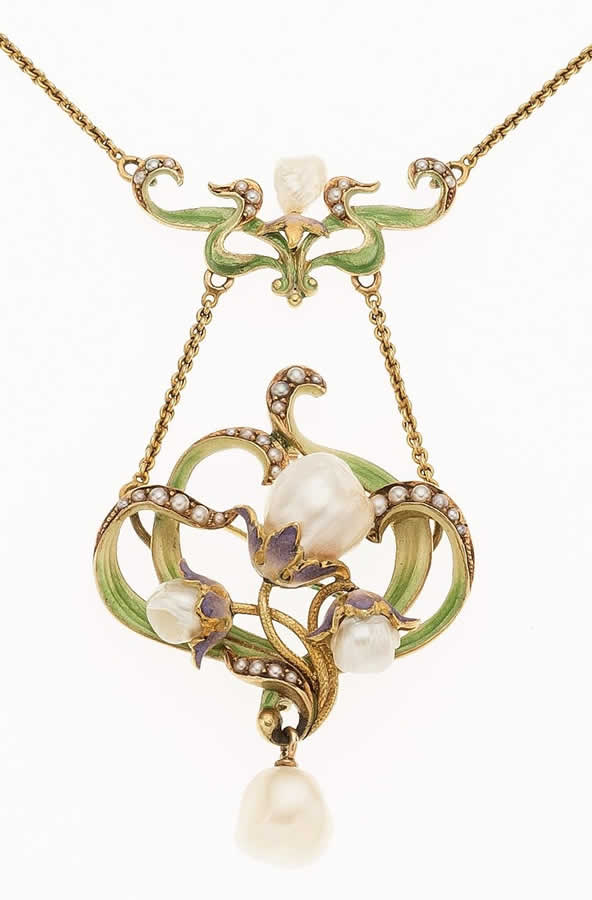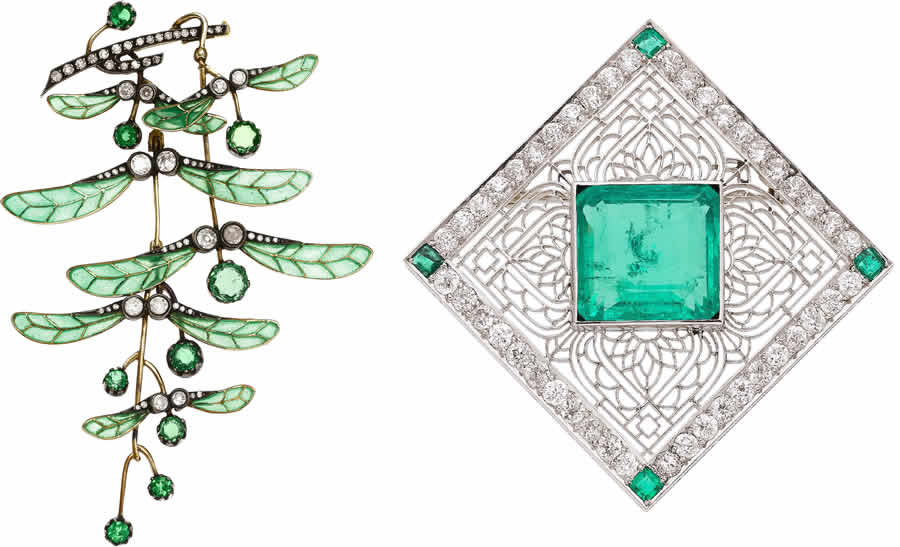VARIETY OF FACTORS MAKE PIECES HARD TO FIND – AND THAT, OF COURSE, IS PIQUING COLLECTOR INTEREST
By Ettagale Blauer
The ethereal jewelry period known as Art Nouveau flourished from about 1895 to 1910, coinciding in time, but not in spirit, with the Edwardian era. Art Nouveau jewelry reflected a new choice of materials, a fresh style and an enthusiastic break with the rigid design motifs that preceded it.
More than 100 years later, collectors are drawn to the delicacy of Art Nouveau designs in combination with the signature motifs of the work. Art Nouveau (“new art”), with its emphasis on the female form coupled with the incorporation of winged creatures – the two morphing into startling new mythological beings – set this jewelry apart visually and philosophically. It was bold in concept and appealed to women prepared to make an equally bold statement and willing to break decisively from Edwardian jewelry.
“This is the first time there were two styles at the same time: Edwardian – the classical Cartier, Louis XVI revival jewelry – and Art Nouveau,” says Nicolas Luchsinger, director of the Heritage Collection for Van Cleef & Arpels. Jewelers generally worked in one style or the other, he says. “The only classic Edwardian jeweler who did venture into Art Nouveau was Boucheron.”
A close look at the designs reveals the dramatic break between the two styles.
Enlarge

CELEBRATING SENSUALITY
Art Nouveau embraced fluid, flowing lines where Edwardian design was geometric and formal. Art Nouveau celebrated female sensuality, while Edwardian was delineated by geometric, rigid designs that still were guided by the mores of the long Victorian period.
Art Nouveau turned its back on traditional jewelry materials. “They did not use previous stones,” Luchsinger notes. “The value is in the design. You never see an important stone in a piece of Art Nouveau.”
They were labor-intensive pieces, created by skilled artist-craftsmen who turned to plique-à-jour enamel, for example, using gem-like translucent glass to paint the wings of the myriad creatures of the insect world. Lalique, whose name is synonymous with the period, used horn to create large but lightweight frames for his pieces. He learned his craft as an apprentice in the workshop of a much lesser-known jeweler, Louis Aucoc.
Enlarge

Where gold was used, it was used sparingly, to form the outlines of female and insect forms, with the female body sometimes sprouting dragonfly or butterfly wings, a recurring hallmark of the period. These shocking motifs, as much as the new materials used to create the jewelry, set it apart from everything else in the marketplace. It took a “new” woman, such as French actress Sarah Bernhardt, to popularize such sensual and bold styles.
The emphasis on artistic expression combined with the use of materials with little intrinsic value put the jewelry into a category intended for true connoisseurs. Buyers, and wearers, needed to appreciate the value of the intent and the labor of the work, rather than the more usual role of jewelry as a readily recognizable display of wealth.
“Japonisme,” with a sense of quiet and elegant beauty and an emphasis on refined, flowing lines, was one of the most important and recognizable influences on Art Nouveau designs. French artists who visited Japan in the second half of the 19th century were inspired by the work of the Japanese, who had labored in isolation for two centuries. Those who didn’t make the trip to Japan could experience the richness of Japanese design at the Paris Exposition of 1867. The purity of Japanese design soon found its way into French design – across material culture and especially in Art Nouveau jewelry.
Enlarge

This “wildly artistic” jewelry is especially appealing to the contemporary buyer, says Jill Burgum, senior director of fine jewelry at Heritage Auctions. “We have gotten accustomed to standard designs, the three-stone rings,” she says. “It is exciting to see artistry brought back to jewelry.” In spite of the work being a century old, “Their craftsmanship speaks to us today,” Burgum says. “These are sculpture in miniature. The use of color, the techniques, were remarkable.”
In terms of makers, Burgum believes the French “are probably the people who produced the best. It was a movement that occurred in the United States, but I think the French knocked it out of the park. I love the idea of the transformation – woman and wings, bats morphing into female bodies, and so on.”
MYSTERIOUS MAKERS
The charm and appeal of Art Nouveau jewelry is matched by its scarcity.
“There is not a lot out there today,” Burgum explains. “Many of the best pieces are now in private collections and in museums. Silvio Denz, owner of Swiss Lalique, set out to buy back Lalique pieces, including jewelry and decorative glass objects, for the namesake company. Now, many can be seen at the Lalique museum in Alsace, France.
Enlarge

“Moreover,” Burgum adds, “I don’t think it was designed to last 100 years. They didn’t tend to use gemstones. It was an artistic movement that utilized plique-à-jour enamel techniques. The best way to explain this is that it is similar to the effect created by a stained-glass window. If the jewelry wasn’t properly cared for, the enamel was often damaged and a challenge to repair. Damaged pieces or pieces that didn’t hold appeal when passed through families were often melted for their gold value.”
Adding to the mystique: Many Art Nouveau pieces were not signed. Instead, makers sold them in jewelry boxes embossed with their names. As for value, Burgum says, “We have seen signed and unsigned. In some cases, the cost of the signed piece is tenfold.” Unless the piece and its box were kept together, identifying the makers can be difficult.
“A lot is not signed,” adds Ulysses Grant Dietz, curator of the Newark Museum in Newark, N.J., a major jewelry manufacturing center at that time. The museum has been collecting jewelry since 1911.
Enlarge

“French makers require certain kinds of marks but not maker’s marks,” Dietz says. “French marks related to the metal the piece was made of, and those were symbols: an eagle’s head referred to a certain karat of gold, for example. If you don’t find any mark, it’s probably not French.” In the United States, there were no requirements at all, he says. “Until the 1960s, U.S. makers did not even have to put a karat mark on jewelry.”
As for jewelry made in Newark for the local market, Dietz explains, “From the 1890s onward, it was identified by a secret code for the wholesaler crowd.” Again, buyers had to rely on the name on the box. Because so much is unsigned, people have to have an eye for the stylistic hallmarks.
Pieces of Art Nouveau jewelry infrequently find their way to the marketplace. But diligent and determined collectors can still find pieces up for sale or auction. The exquisite beauty of the work makes the search very much a labor of love.
ETTAGALE BLAUER is a New York-based writer specializing in period and contemporary jewelry, as well as all aspects of diamonds.
Ramping Up
SENIOR DIRECTOR OF FINE JEWELRY JILL BURGUM EXPLAINS HERITAGE AUCTIONS’ GROWTH IN THE LUXURY CATEGORY
Heritage Auctions recently boosted its staff from three jewelry specialists to seven. What’s driving this expansion?
Our business has grown steadily over the past 10 years. We felt that in order to continue growing the department, we needed to make ourselves more accessible to clients and that meant ramping up staffing in several locations.
Enlarge

So Heritage now has jewelry specialists in which cities?
New York, Palm Beach in Florida, Chicago, Dallas, Beverly Hills and San Francisco.
What makes Heritage unique among auction houses that deal in estate jewelry?
We are very approachable. And as a middle market player, there isn’t much that we cannot help our clients with. We also have an amazing website, HA.com, with a lot of information and resources for clients to take advantage of.
What’s “hot” in colored stones right now – rubies, sapphires, emeralds?
Buyers are seeking very fine quality colored gems, namely Colombian emeralds, rare Kashmir sapphires and Burma rubies.
Tell us more about why Art Nouveau jewelry is so hard to find these days?
The Art Nouveau movement was fairly small and rather short-lived in the overall jewelry scheme. It was wildly artistic and brought forth themes that to some were shocking – metamorphosis and the nude female form. There wasn’t a lot of it produced to begin with, and that which has survived has become quite rare and much sought-after.
So is the demand for Art Nouveau jewelry driving up prices?
In some cases, yes. It is important to realize that Art Nouveau jewelry is like other collectible jewelry eras, like Edwardian or Art Deco, in that there are very well-made pieces as well as nice pieces. The rarity of finding the very well-made pieces by particular designers ups the value exponentially.

